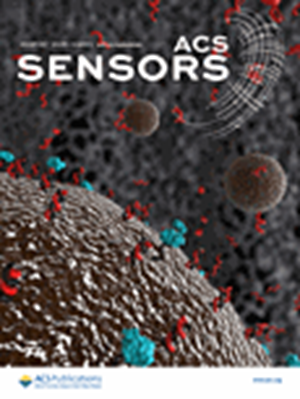调谐等离子体探针的聚集以阐明诊断策略
IF 8.2
1区 化学
Q1 CHEMISTRY, ANALYTICAL
引用次数: 0
摘要
通过系统地改变等离子体探针的长度和浓度来调整基于金纳米粒子(GNP)的聚集分析,这是影响检测范围和灵敏度的两个关键因素。等离子体探针通过不同分子量的聚乙二醇(PEG)连接物将抗体偶联到固定大小的GNPs上。这些探针在检测a型流感病毒标志物血凝素(HA)蛋白时的性能进行了评估,重点关注了局部表面等离子体共振的相应位移。结果表明,较短的等离子体探针表现出更高的灵敏度,产生更明显的比色信号,从而实现更广泛的检测范围。此外,探针浓度对调节HA蛋白的可测量浓度范围至关重要。使用等离子体标尺方程的定量分析证实,由探针长度和浓度控制的粒子间距离是测定性能的关键决定因素。我们的研究为基于gnp的诊断工具的设计提供了见解,这些工具允许为特定应用量身定制检测范围。这些发现表明,通过微调等离子体探针参数,可以优化灵敏度和检测范围之间的平衡,为设计即时诊断分析提供一种通用方法。本文章由计算机程序翻译,如有差异,请以英文原文为准。

Tuning the Aggregation of Plasmonic Probes to Shed Light on Diagnostic Strategies
Gold nanoparticle (GNP)-based aggregation assays were tuned by systematically varying the length and concentration of the plasmonic probes, which are two critical factors that influence the detection range and sensitivity. Plasmonic probes were engineered by conjugating antibodies to fixed-size GNPs via poly(ethylene glycol) (PEG) linkers of varying molecular weights. The performance of these probes was evaluated in the detection of hemagglutinin (HA) protein, a marker of the influenza A virus, with a focus on the corresponding shifts in localized surface plasmon resonance. The results demonstrated that shorter plasmonic probes exhibited enhanced sensitivity and produced more pronounced colorimetric signals, thereby achieving a broader detection range. Additionally, the probe concentration was critical for modulating the measurable concentration range of the HA protein. Quantitative analysis using the plasmon ruler equation confirmed that the interparticle distance, governed by the probe length and concentration, is a key determinant of assay performance. Our study provides insights into the design of GNP-based diagnostic tools that allow customizable detection ranges tailored to specific applications. These findings suggest that by fine-tuning the plasmonic probe parameters, the balance between sensitivity and detection range can be optimized, offering a versatile approach to the design of point-of-care diagnostic assays.
求助全文
通过发布文献求助,成功后即可免费获取论文全文。
去求助
来源期刊

ACS Sensors
Chemical Engineering-Bioengineering
CiteScore
14.50
自引率
3.40%
发文量
372
期刊介绍:
ACS Sensors is a peer-reviewed research journal that focuses on the dissemination of new and original knowledge in the field of sensor science, particularly those that selectively sense chemical or biological species or processes. The journal covers a broad range of topics, including but not limited to biosensors, chemical sensors, gas sensors, intracellular sensors, single molecule sensors, cell chips, and microfluidic devices. It aims to publish articles that address conceptual advances in sensing technology applicable to various types of analytes or application papers that report on the use of existing sensing concepts in new ways or for new analytes.
 求助内容:
求助内容: 应助结果提醒方式:
应助结果提醒方式:


